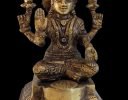The Timeless Beauty of the Bronze Buddha Statue: A Journey Through Art and Spirituality

For centuries, the Bronze Buddha Statue has been a symbol of serenity, wisdom, and artistic mastery. Found in temples, gardens, homes, and art galleries around the world, these statues are more than decorative objects—they are embodiments of cultural heritage and spiritual devotion. A Buddha Sculpture, whether ancient or modern, serves as both a work of art and a reminder of inner peace.
A Brief History of the Bronze Buddha Statue
The tradition of creating Buddha sculptures dates back over 2,000 years, with early examples emerging in India and spreading through Southeast Asia, China, Korea, and Japan. Bronze became a favored medium because of its durability, fine detailing, and ability to develop a beautiful patina over time.
During the Tang Dynasty in China and the Kamakura period in Japan, the Bronze Buddha Statue reached new levels of refinement. Artisans perfected casting techniques, allowing them to create statues with lifelike expressions and intricate robes. These sculptures were not only religious icons but also national treasures, representing the height of craftsmanship in their respective cultures.
The Artistic Significance of Buddha Sculptures
A Buddha sculpture is instantly recognizable by its serene expression, meditative posture, and symbolic hand gestures known as mudras. Each detail is intentional:
The Usnisha (cranial bump) represents wisdom.
The elongated earlobes signify renunciation of material wealth.
The lotus seat symbolizes purity, rising above worldly troubles.
Bronze allows artisans to render these features with remarkable precision. The metal’s strength supports delicate designs, from the folds of a robe to the subtle curve of a smile. This is why many collectors and temples specifically seek a Bronze Buddha Statue over those made of stone or wood.
Spiritual Meaning Behind the Bronze Buddha Statue
Beyond their artistic qualities, Buddha sculptures carry deep spiritual meaning. The Buddha’s calm demeanor is a visual representation of enlightenment—a state of freedom from suffering and attachment. For practitioners of Buddhism, placing a Bronze Buddha Statue in a home or meditation space is a way to inspire mindfulness, compassion, and balance.
The posture of the statue also matters. A seated Buddha in the lotus position often represents meditation and inner peace, while a standing Buddha may symbolize compassion and teaching. The choice of a Bronze Buddha Statue can reflect the values or aspirations of the owner.
The Process of Creating a Bronze Buddha Statue
The creation of a Bronze Buddha Statue is a meticulous process, often requiring months of work by skilled artisans. Many use the “lost-wax” casting method, which has remained largely unchanged for centuries. The process involves:
Sculpting a model from wax.
Covering it in clay or plaster to create a mold.
Melting away the wax and replacing it with molten bronze.
Finishing the statue by hand-polishing, engraving details, and applying patina.
Because bronze is a highly durable material, these statues can last for generations, making them heirlooms passed down within families or revered in temples for hundreds of years.
Choosing the Right Buddha Sculpture for Your Space
Whether you’re an art collector, a spiritual seeker, or simply someone who appreciates fine craftsmanship, choosing the right Buddha sculpture requires careful thought. Consider:
Size: Large statues make a statement in gardens or temples, while smaller ones suit indoor spaces.
Posture and Mudra: Select one that aligns with your personal values or spiritual goals.
Craftsmanship: Look for detailed work, balanced proportions, and a harmonious expression.
Material: A Bronze Buddha Statue offers timeless durability and elegance.
Placement is also important. In many traditions, a Buddha statue should be placed at eye level or higher, facing the entrance of a room to invite positive energy.
Caring for a Bronze Buddha Statue
A Bronze Buddha Statue requires minimal maintenance, but proper care will preserve its beauty for decades. Dust regularly with a soft cloth and avoid abrasive cleaners that could damage the patina. If placed outdoors, occasional waxing can protect the metal from weathering, though many owners embrace the natural green patina that develops over time.
Why the Bronze Buddha Statue Remains Popular Today
In a fast-paced, digital world, the enduring popularity of the Bronze Buddha Statue may seem surprising—but in many ways, it’s exactly what we need. These statues serve as gentle reminders to slow down, breathe, and focus on what truly matters. They bridge the gap between art and spirituality, offering both visual beauty and emotional grounding.
A Buddha sculpture isn’t just an object; it’s a reflection of humanity’s quest for peace and understanding. Whether displayed in a temple, a modern apartment, or a tranquil garden, it carries the same quiet strength that has captivated people for millennia.
Final Thought:
Owning a Bronze Buddha Statue is more than acquiring a piece of art—it’s welcoming a symbol of peace, wisdom, and timeless beauty into your life. In a world full of distractions, a simple glance at a serene Buddha sculpture can be enough to bring you back to center.
If you’d like, I can also format this blog with SEO-optimized headings, meta description, and internal linking structure so it’s ready for publishing. Would you like me to do that next?
ABOUT ME

Welcome to my blog Artcle slurp. We share latest article for all niche. If you want to publish your article then mail me on articleslurpblog@gmail.com































